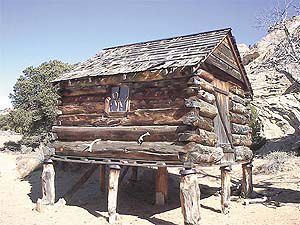| This historic cabin on Sid’s Mountain holds great value to the farming and ranching families in Emery County. |
The historic cabin on Sid’s Mountain in the San Rafael Swell has been, and continues to be, a great hiking destination and learning experience for anyone who undertakes the trip. Many area Scouts go each year, along with many hunters and sightseers.
Emery County Commissioner Gary Kofford has family ties to the builders of the cabin and is always eager to learn more from anyone who has tidbits about the cabin’s history. “I have done some research into the origins of the cabin, and I learned something from Kenn Kofford just this morning,” stated Kofford. “I am always eager to hear about the history of the place.”
Kofford’s grandfather, Clayton Kofford, was running cows in the San Rafael area during the Depression Era of the 1930s. Other locals, such as Vern Kofford, Clyde Kofford, Sammy Aiken, and Byron Johansen also grazed livestock in the Sid’s Mountain and North Sid’s Mountain area. Clayton Kofford decided to take out a homestead under the Homestead Act and prove up on it.
The Homestead Act was a United States Federal law that gave freehold title to 160 acres of undeveloped land in the American West. The person to whom title was granted had to be at least 21 years of age, and to have built on the section, and lived there for five years, in a house that was at least 12 by 14 feet in size. The Act was signed into law by President Abraham Lincoln on May 20, 1862. The Federal Land Policy and Management Act of 1976 ended homesteading; the government believed that the best use of public lands was for them to remain in government control.
Clayton’s father, George, lived in a tent near the site of his cabin, in Long Hollow where he built the first cabin near the water tanks. Clayton and his sons, built the cabin which remains today. In later years with a team of horses, Clayton pulled George’s cabin closer to his own.
| The woodstove hauled in by Newell Kofford and Clyde Kofford sits inside the historic cabin. |
The cabin which Clayton and his sons built was constructed of yellow pine logs which they cut near the site of the home. The corner posts are cedar posts buried upright in the ground with two-three feet above ground level. On the top of the post, they installed pie plates and then put the cabin on these posts. The elevated cabin, with the pie plates on the posts, was done to deter mice and other vermin from entering the cabin.
Shingles and a wood stove were the only items hauled in for the construction of the cabin. Don Kofford was one of Clayton’s younger sons and Gary’s father. He remembers the construction of the cabin being done in 1936-1937, as he was in his early teen years. Vern Kofford’s son Clyde, and Clayton’s son Newell, hauled the woodstove in on horseback, and that is also how the cedar shingles were hauled in to the construction site.
Gary Kofford relates a story of how a Fresno, (a scraping board) came to be under the existing cabin. Jeffs said Rex Kofford and himself hauled the Fresno into the cabin site to build a pond. He continued that Rex was out of cigarettes and decided to go back to town and Jeffs went with him. The two never were able to return to the cabin to scrape out the pond area, and the Fresno remains under the cabin today.
When the homestead had been proved up on, the paper to grant ownership to Rex Kofford, Clayton’s son, was issued on Dec. 16, 1942. The cabin and surrounding 440 acres remained in Rex’s name until August of 1945 and then was deeded to Clayton.
Clayton retained ownership until 1948 when he sold the property to Loran Beach in November of that year. The Beach family retained ownership of the property for 20 years and continued to use the property for cattle grazing.
| Cedar posts with pie plates on top form the foundation work to deter rodents from entering the cabin. |
On Jan. 30, 1968, Beach sold the property to Russell Allred of Cleveland. Ten years later, Allred sold it to Energy Fuels who held onto it for seven years, then the property went into the ownership of the Bureau of Land Management in 1985.
Since the BLM came to control Sid’s Mountain, the entire area has been designated Wilderness Study area and can only be accessed by foot or horse travel. Only the hardiest of hikers make the 13 mile trek into the cabins, but their rich history is tied to all the families of ranchers and farmers who grazed cattle in the area.
During the early days of the cabin’s existence, many people used it besides the owner. It came to be used as a line cabin for others who had livestock nearby as a shelter from the weather. Some were even known to leave spare food behind for others traveling through who might be hungry.
Many families in Emery County can relate stories about their forebearers use of the cabin on Sid’s Mountain.
If the cabin on Sid’s Mountain could talk and tell the stories of its inhabitants over the past eight decades and how they came to be in the cabin, the history would be very interesting indeed.
These historic pieces of Emery County’s past should be preserved and protected for future generations.

